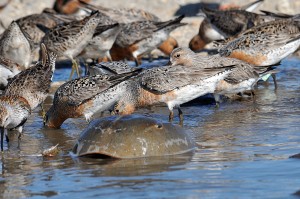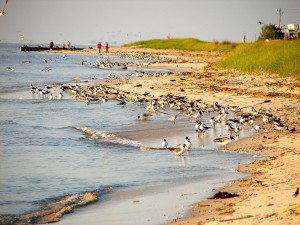24 October 2014
Hurricane Sandy restoration saves shorebirds, ‘living fossils’ they rely on
Posted by kwheeling
By Kate Wheeling

Red Knots feast on horseshoe crab eggs in the Delaware Bay, fueling the last leg of their 14,500 kilometer (9,000 mile) journey from the tip of South America to the Arctic.
Credit: Gregory Breese/USFWS
When Hurricane Sandy hit the U.S. East Coast two years ago, it threatened the survival of a 400-million-year-old crab species and about a million shorebirds that rely on the crabs’ eggs for nourishment during long migrations. Retreating storm waters took with them 60 to 90 centimeters (two to three feet) of sand from the Delaware Bay beaches where horseshoe crabs lay eggs and left behind piles of debris, destroying 70 percent of the crab’s prime nesting zones in the area.
Now, preliminary data shows that a speedy rescue project, funded in part by federal Hurricane Sandy emergency relief funds, helped restore the beaches, and that horseshoe-crab and shorebird numbers have returned to their pre-storm levels.
“Some of the hardest hit areas were those that were the most important for shorebirds, as well as horseshoe crabs. We had to restore the beaches immediately to provide the necessary forage for shorebirds before the next spring,” said Eric Schrading, a New Jersey Field Office Supervisor for the U.S. Fish and Wildlife Service.
Schrading described the destruction and the rescue operation during a congressional briefing last month about the U.S. Department of the Interior’s response to Hurricane Sandy.
The restoration project, an effort of the American Littoral Society, the Conserve Wildlife Foundation and the U.S. Fish and Wildlife Service, removed over 700 metric tons (1.5 million pounds) of debris and laid down more than 40,800 metric tons (nearly 90 million pounds) of sand across five beaches in the Bay.
“Indications are that we’ve, at least, created a beach that is providing as much ecological value as it did before the storm,” Schrading added.
Every spring, the largest population of horseshoe crabs in the world turns up to spawn in the Delaware Bay, a calm cove sheltered from the choppy Atlantic Ocean waves by a protective arm of the New Jersey Cape. At night, tens of thousands of the dinner-plate sized crabs plod up onto the beach, dig down into the sand and leave behind millions of eggs.
Shortly after the crabs invade the bay, flocks of shorebirds, including one species called Red Knots, pass through the area. The Red Knots feast on the unlucky eggs that end up on the surface of the overturned sand, fueling the birds on the last leg of their 14,500 kilometer (9,000 mile) journey from the tip of South America to the Arctic.

Roughly one million shorebirds pass through the Delaware Bay in the spring, when the largest population of horseshoe crabs in the world turns up to spawn.
Credit: smallbones/wikimedia
“Delaware Bay is the top migratory stop for shorebirds in the nation, and one of the top stopovers in the world,” said Larry Niles, a wildlife biologist and one of the founders of Conserve Wildlife Foundation, a New Jersey-based group working to protect rare and threatened species within the state.
The restoration project is just the latest in a series of efforts to protect the horseshoe-crab population on the Atlantic coast.
Although the crabs haven’t changed much since they first appeared in the fossil record over 400 million years ago, harvesting in the 1990s reduced the population of this “living fossil” to just a quarter of its original size, according to Niles. Without an abundance of horseshoe crab eggs to feed on in the spring, shorebird populations also dwindled. Red Knot numbers plummeted to fewer than 20,000 birds in the last decade from more than 100,000 birds in the 1980s.
Increased regulation of horseshoe-crab harvesting in the late 1990s began to turn things around for the crabs and birds. Shorebird numbers had reached a rough equilibrium with the availability of crab eggs when Hurricane Sandy hit, said Niles.
Now that efforts to restore the beach after the 2012 storm seem to be working, the focus of the U.S. Fish and Wildlife Service has shifted to protecting the bay from future storms, according to Schrading.
One option, he said, is oyster aquaculture. Stretches of oyster-filled cages maintained by New Jersey’s own oystermen could be deployed off the coast of Delaware Bay’s beaches. Scientists believe the cages could act as a buffer for the beach while also benefiting local fishermen.
The cages could be in place as early as next spring, but according to Schrading it will take at least two years of monitoring to tell if they effectively prevent strong waves from eroding the beaches without interfering with horseshoe crab movements in the bay.
“[The project] is experimental in design, but it is something that’s worth looking into,” he said.
The September 19 congressional briefing highlighted the various ways the U.S. Fish and Wildlife Service, the National Park Service and the U.S. Geological Survey (USGS) used federal Hurricane Sandy emergency funds to rebuild coastal communities and landscapes after the storm. Schrading was joined by Mary Foley, chief scientist for the National Park Service, and Neil Ganju, a research oceanographer for USGS, who presented on their agencies’ contributions to the restoration and resiliency efforts following the storm.
Read more from GeoSpace on the briefing here.
– Kate Wheeling is a science writing intern in the AGU’s Public Information department.


 GeoSpace is a blog on Earth and space science, managed by AGU’s Public Information staff. The blog features posts by AGU writers and guest contributors on all sorts of relevant science topics, but with a focus on new research and geo and space sciences-related stories that are currently in the news.
GeoSpace is a blog on Earth and space science, managed by AGU’s Public Information staff. The blog features posts by AGU writers and guest contributors on all sorts of relevant science topics, but with a focus on new research and geo and space sciences-related stories that are currently in the news.